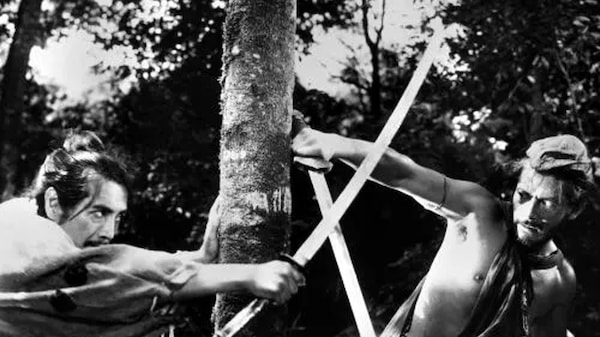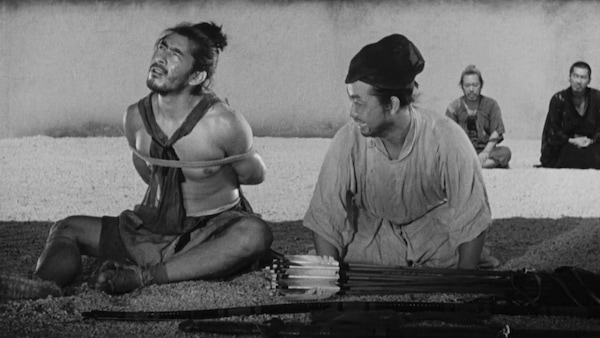Monsoon Magic: How Akira Kurosawa uses rain as a symbolism in his masterpiece Rashomon
Released in 1950, Akira Kurosawa’s Rashomon won the coveted Golden Lion at the Venice Film Festival in 1951.

Last Updated: 09.00 PM, Jul 24, 2022
Akira Kurosawa is considered as one of the greatest filmmakers to have graced the planet and his impressive filmography has stood the test of time. Many of his films such as Seven Samurai and Ran are study material to many budding filmmakers even today. Among his legendary body of work is the 1950 classic, Rashomon. One of the filmmaker’s most noted works, Rashomon has a lot to offer its viewers, who can spend entire days decoding and analysing it. The first Japanese film to receive significant international recognition, Rashomon is also considered as one of the greatest films to ever be made.
The film’s status in the world is so big that it helped coin the term “The Rashomon Effect”. The film tells an event from the subjective look of various people, all of whom willingly offer a different variation of the story for their self-interest. This film technique and techniques inspired from Rashomon has been used in films since, including Kamal Haasan’s Virumaandi in 2004. While every element of the film including its camera work to setting was done for a reason, the filmmaker also went the extra mile to make rain a very important element in Rashomon.
The story kicks off as a woodcutter and a priest runs for safety into a desolate looking Rashomon Gate to get away from heavy downpour. A commoner also joins the duo and tells them about a shocking story that he has heard - the story of the murdered Samurai and his wife. He reveals what is interesting about it is that everyone involved with it has given a different account to the story.
The woodcutter then claims that he had reported the incident to the authorities and they are summoned to court. There they find the infamous bandit Tajōmaru who tells his recollection of the events. He is smitten by a Samurai’s wife and he follows the two of them to the forest. He says that he redirects the Samurai in the intention of raping his wife and he succeeds in doing so. He says the wife then asks him to duel the Samurai and kill him to save her from guilt. According to him, he then kills the Samurai and finds that the wife has fled the scene. Then the question arises about the wife’s expensive dagger, which he says he did not care for at the time and doesn’t know about its whereabouts.

Then we get to head the wife’s story, where she says that Tajōmaru raped her and left and she begged her husband to kill her due to the dishonour that has occured to her. She then says that she faints in the pressure and that when she wakes up, she saw her husband had killed himself.
Then, the dead Samurai himself speaks about the incident through a medium, and says that after Tajōmaru rapes his wife, she asks Tajōmaru to kill him so she does not have to live with guilt. Tajōmaru does not take this well and gives the Samurai the option to either kill her or let her go. She flees and Tajōmaru follows her though the forest and while they are gone, the Samurai kills himself with the wife’s dagger. He also adds that someone takes the dagger away from his chest, but does not reveal who it is.
The woodcutter then in present time tells the priest and the commoner that all three stories are lies and that he had witnessed the whole thing, but hid it because he did not want to testify. He ends the story by saying that after the rape, the Samurai and Tajōmaru duel and the bandit wins by a stroke of luck and the wife flees the scene.
Right after this, they hear an infant crying and they find an infant has been left at Rashomon Gate with an amulet that has been left for the child. The commoner takes the amulet away from the infant to the shock of the other two. When questioned, he reveals that the woodcutter was the one who stole the expensive dagger from the forest and that he had no right to question him. The priest is shaken by the revelation, after which the woodcutter says that he will take the infant home and raise it like one of his other six children.

The priest then adds that everything he heard and saw had made him lose faith in humanity, but the woodcutter’s decision has given him hope again. The fact that he has a big family to take care of, puts him in a new light for having done the theft of the dagger. As they part ways, the heavy downpour has ended and the grey clouds have now moved away.
Now, what part does rain play in all of this? We constantly see rain in the backdrop of the scenes in Rashomon Gate, and the story has it that Kurosawa took over an entire village’s water source to produce the rain for his shots. Another story says that because the rain was not evidently visible in the grey shots, he poured ink in the rain machine to make it more visible. Now simply because he went through all this to make rain such a big detail in the film, there has to be a big reason as well right?
Well much like every other detail in the movie, the rain also has a reason to be a part of the film. It is important to know that writing something such as this is always subjective and there could be other deductions as well. We can learn that Kurosawa’s rain symbolised the wrath of mother nature and everything that humanity has brought upon itself (the film was made following the two World Wars). This cataclysmic destruction was also what brought down the once majestic Rashomon Gate, which in itself, is a symbolism for civilisation. The opening frame of two men running into the gate is also a visual art about how humanity is constantly running towards destruction.
Coming back to rain, it does not end here. The downpour is relentless and the entire scene is dark. As we constantly listen to different people twisting the truth for whatever little reason that they had, the world is hidden in darkness by the clouds with destruction raining down on us. This becomes evident when the rain stops and the dark clouds clear to reveal the sun after the woodcutter decides to take care of the abandoned baby.
Coming to the sun, Kurosawa and cinematographer Kazuo Miyagawa pans the camera straight to the sun as we see the story in the forest first unfolding. This is a subtle nod to the fact that like the sun blinds the viewers, each of the stories we are about to hear are meant to blind people by the ones who are narrating the tale. Adding this little detail to when the sun comes back out at the end of the film, it gives more meaning to the rain and the sun.

Now, for anyone who hasn’t seen this masterpiece, please do watch it when you have free time. Even better, watch the film the next time there is a heavy downpour and the dark clouds cover the sun, because as you know, not much has changed in the world since Rashomon was masterfully filmed by Kurosawa.
For a film that is over 60 years old, the filmmaking and the subtle details of Rashomon holds up like fine wine. While a lot of the story, especially revolving the rape of the wife and how she reacts to it are without doubt wrong, the film is still a must watch just to witness how a master filmmaker uses every element in his disposal to weave a story that has a whole lot of layers.
Apart from the rain element, the film has a long list of symbolisms from the forest to the baby. And it does not stop here, film buffs could even get the idea of how the director decides to capture Tajōmaru’s movements as he stalks the Samurai and the wife, just like how a predator would stalk its prey. There are also a string of closeups that are down in the forest, revolving between the Bandit the wife and the Samurai, and it asks the viewers more questions as to what Kurosawa would have meant by it. Even how the sunlight enters the forest has meaning to it. There are even minute details in the editing such as how much time the camera lingers on each character that tells a lot.
So the next time it starts raining, make sure that you watch this masterpiece from one of the greatest filmmakers to have ever lived. Watch the film and then you would start making your own stories about the rain that is happening outside your window. Rashomon is available to stream on Vimeo.
